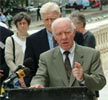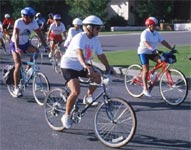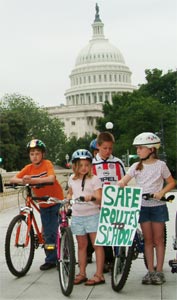Pedestrian and Cyclist Equity Act (PACE)
Congress Supports Cycling and Safe Communities
 Congressman James Oberstar has taken a major step forward in supporting bicycling, walking and healthy communities with his introduction of the Pedestrian and Cyclist Equity Act of 2003 (PACE). With programs aimed at improving safety and infrastructure for pedestrians, cyclists and the disabled, PACE would receive over $575 million annually from the Department of Transportation through 2009.
Congressman James Oberstar has taken a major step forward in supporting bicycling, walking and healthy communities with his introduction of the Pedestrian and Cyclist Equity Act of 2003 (PACE). With programs aimed at improving safety and infrastructure for pedestrians, cyclists and the disabled, PACE would receive over $575 million annually from the Department of Transportation through 2009.
Transportation and Active Living Program
The Transportation and Active Living Program creates, enhances and promotes community environments that improve opportunities for people to be physically active in their daily lives. The  program aims to promote healthy living through changes in transportation, community design, and architectural policies and programs. Examples of initiatives include the integration of land use and transportation planning to promote non-motorized travel choices; incorporate pedestrian- and bicycle-friendly features into community planning or legislative initiatives; develop campaigns and provide technical assistance for safe routes to school; enhance accessibility and mobility initiatives for people with disabilities; and implement public advocacy campaigns to promote physical activity. Eligible applicants include state, local, or regional agencies, and nonprofit organizations.
program aims to promote healthy living through changes in transportation, community design, and architectural policies and programs. Examples of initiatives include the integration of land use and transportation planning to promote non-motorized travel choices; incorporate pedestrian- and bicycle-friendly features into community planning or legislative initiatives; develop campaigns and provide technical assistance for safe routes to school; enhance accessibility and mobility initiatives for people with disabilities; and implement public advocacy campaigns to promote physical activity. Eligible applicants include state, local, or regional agencies, and nonprofit organizations.
The Transportation and Active Living grant program administered by the Secretary of Transportation dedicates $25 million from the Highway Trust Fund annually from 2004 through 2009. To assure a broad distribution of funds, the total amount awarded to applicants in any state cannot exceed $1 million for a fiscal year.
Safe Routes to School Program
Under the PACE Act, the Secretary of Transportation would establish and implement a Safe Routes to School program for the benefit of children in primary and middle schools. The program would include provisions for planning, infrastructure improvement, and public awareness. Infrastructure-related projects to encourage walking and bicycling to school could include sidewalk improvements; traffic-calming and speed-reduction improvements; on-street bicycle facilities; off-street bicycle and pedestrian facilities; and secure bicycle-parking facilities.
 Funds can also be used for non-infrastructure-related activities including public-awareness campaigns and outreach to press and community leaders. Programs could also include traffic education and enforcement in the vicinity of schools; student sessions on bicycle and pedestrian safety, health, and environment; and funding for training, volunteers, and coordinators of safe routes to school programs. Plus, funding will be available for a national nonprofit organization to operate a national Safe Routes to School clearinghouse, develop information and educational programs on safe routes to school, and provide assistance in implementing successful Safe Routes to School programs. Not less than 10 percent of amounts apportioned to a state must be used for non-infrastructure-related activities.
Funds can also be used for non-infrastructure-related activities including public-awareness campaigns and outreach to press and community leaders. Programs could also include traffic education and enforcement in the vicinity of schools; student sessions on bicycle and pedestrian safety, health, and environment; and funding for training, volunteers, and coordinators of safe routes to school programs. Plus, funding will be available for a national nonprofit organization to operate a national Safe Routes to School clearinghouse, develop information and educational programs on safe routes to school, and provide assistance in implementing successful Safe Routes to School programs. Not less than 10 percent of amounts apportioned to a state must be used for non-infrastructure-related activities.
To fund the program, the Highway Trust Fund would provide $250 million annually from 2004 through 2009. Funds will be apportioned among the states on the basis of total student enrollment in primary and middle schools, and no state will receive an apportionment of less than $2 million per year. Eligible recipients include state, local or regional agencies, including nonprofit organizations. A report conducted by a task force composed of leaders in health, transportation, education, and representatives of appropriate federal agencies will examine strategies for advancing the safe routes to school programs nationwide, and will be submitted to Congress no later than March 30, 2005.
Non-motorized Transportation Pilot Program
PACE also includes a non-motorized transportation pilot program that involves constructing, in three communities, a network of non-motorized transportation infrastructure facilities, including sidewalks, bicycle lanes and pathways, that connect directly with transit stations, schools, residences, businesses and other community activity centers. The purpose of the program is to demonstrate the extent to which bicycling and walking can carry a significant part of the transportation load, and represent a major portion of the transportation solution.
In carrying out the program, the Secretary will develop statistical information on changes in motorized, non-motorized and transit use in communities participating in the program. The Secretary will transmit to Congress an interim report in 2007, and a final report in 2010, on the results of the program. Funding for the pilot program will consist of $180 million from the Highway Trust Fund and $45 million from the Mass Transit Account of the Highway Trust Fund, over the six-year life of the bill.
You Can Help Too!
America Bikes and a number of other organizations are mobilizing their members to build Congressional support for the bill. More information is available at the America Bikes website.
Martha Roskowski, Campaign Manager, America Bikes 202-833-8080 Jim Berard, House Transportation Committee (Congressman Oberstar) 202-225-6260
For more information, contact:
